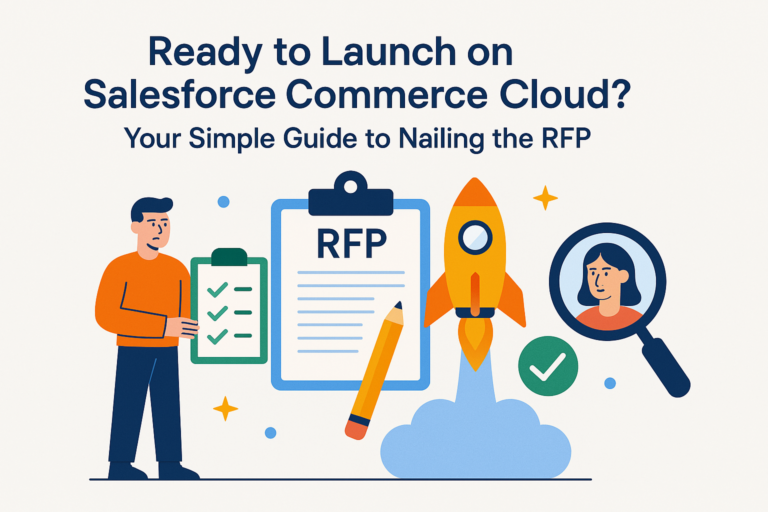Ready to Launch on Salesforce Commerce Cloud? Your Simple Guide to Nailing the RFP
So, you’ve decided Salesforce Commerce Cloud (SFCC) – the powerhouse platform that used to be Demandware – is the right engine for your online store. Awesome choice! It’s robust, scalable, and packed with features. But before you jump in, you need the right team to build or transform your vision into a reality. That’s where the Request for Proposal (RFP) comes in.
Think of an RFP not as a boring corporate document, but as your matchmaking profile for finding the perfect SFCC implementation partner. It tells potential partners who you are, what you dream of building, and what you expect from them. A great RFP saves you time, money, and headaches down the road.
Let’s break down how to create and submit an SFCC RFP that gets you the best results, in simple terms.
Step 1: Look in the Mirror (Before You Write Anything!)
Before you even think about writing the RFP, get your own house in order. This is crucial!
- Know Your “Why”: Why SFCC? What specific business goals are you trying to achieve? (e.g., Increase online sales by 30%? Expand into new countries? Offer a slicker mobile experience? Launch a B2C/B2B portal?) Be crystal clear.
- Dream Big, But Be Real: What does your ideal SFCC store look like? What features are absolute must-haves (like specific payment options, loyalty programs, complex product finders)? What are nice-to-haves?
- Talk to Your Team: Get input from everyone who’ll touch the website – marketing, sales, IT, customer service, finance. What are their needs and pain points with the current setup (or lack thereof)?
- Budget Honesty: Have a realistic budget range in mind. Implementation partners need this to propose feasible solutions. It’s okay if it’s a range, but “we have no idea” isn’t helpful.
- Timeline Goals: When do you realistically want to launch? Consider holidays, peak seasons, and the fact that quality work takes time.
Step 2: Write Your “Dating Profile” (Crafting the RFP Document)
Now, let’s put pen to paper (or fingers to keyboard). Structure your RFP logically. Here’s a simple flow:
Introduction: About Us & Our Project
- Who are you? Briefly introduce your company, your brand, what you sell, and who your customers are.
- What’s the project? Clearly state you’re looking for an SFCC implementation partner. Is it a brand new site? A replatform from another system (mention which one!)? An upgrade? A specific set of new features?
- What are your big goals? Reiterate the key business objectives from Step 1.
The Vision: What We Want to Build
- Functional Needs: Describe what the website needs to do from a user’s perspective. Think about:
- Browse & Searching (categories, filters, search features)
- Product Details (images, descriptions, swatches, reviews)
- Shopping Cart & Checkout (guest checkout, payment types, shipping options, taxes)
- My Account (order history, saved addresses, wishlists)
- Content Pages (About Us, Contact, Blog, Lookbooks)
- Mobile Experience (responsive design is standard, but do you need a dedicated app or PWA?)
- Marketing Tools (promotions, email integration, personalization – mention SFCC Einstein if relevant)
- International Needs (multiple languages, currencies, sites?)
- B2B Features (if applicable – custom catalogs, quote requests, buyer roles)
- Technical Needs (Keep it High-Level): You don’t need to be a tech genius, but mention:
- Integrations: What other systems must connect to SFCC? (ERP, CRM like Salesforce Sales Cloud, Order Management System (OMS), PIM, payment gateway, tax service, email marketing platform). Be specific!
- Data Migration: What data needs to move? (Customers, orders, products). How much? From where?
- SFCC Specifics (Optional but helpful): Are you leaning towards SFCC’s traditional SiteGenesis/SFRA architecture or exploring the newer Composable Storefront (PWA Kit & Managed Runtime)? Mentioning this shows you’ve done some homework.
- Design & User Experience (UX): Do you have existing brand guidelines? Wireframes? Or do you need the partner to handle design from scratch? What’s your vision for the look and feel?
- Functional Needs: Describe what the website needs to do from a user’s perspective. Think about:
The Rules of Engagement: Scope, Timeline & Budget
- Scope: Clearly define what’s in this project and what’s out. (e.g., “Phase 1 includes US site launch; international expansion is Phase 2 and out of scope for this RFP”).
- Timeline: State your desired project milestones and go-live date. Ask partners for their proposed timeline.
- Budget: Reiterate your budget range.
Questions for Your Potential Partners: This is where you vet them! Ask things like:
- Tell us about your SFCC experience (years, number of launches, specific industry experience).
- Share case studies of similar projects (size, complexity, industry).
- Who would be on our project team? Introduce us to the key players and their experience.
- What’s your project management methodology (Agile, Waterfall)? How do you communicate progress?
- How do you handle testing and quality assurance?
- What does your post-launch support look like? (Warranties, retainers, training).
- Provide a detailed cost breakdown (discovery, design, development, testing, training, support).
- What are the potential risks you foresee, and how would you mitigate them?
- Why are you the best partner for us?
How We’ll Choose: Evaluation Criteria & Next Steps
- Briefly explain how you’ll evaluate proposals (e.g., SFCC expertise, relevant experience, technical approach, team quality, cultural fit, cost).
- Outline the timeline for the RFP process: Deadline for questions, deadline for submission, when you expect to shortlist, conduct interviews/demos, and make a final decision.
Step 3: Find Your Matches (Identifying Potential Partners)
Don’t just send your RFP into the void. Research potential SFCC implementation partners:
- Salesforce Partner Finder: Use Salesforce’s official directory. Filter by expertise, region, and tier.
- Ask Around: Network, ask Salesforce reps, or get recommendations from other businesses using SFCC.
- Look at Their Work: Check out their websites, case studies, and client lists.
Choose a manageable number (maybe 3-7) of partners that seem like a good fit based on their size, experience, location, and industry focus.
Step 4: Send it Out & Manage the Process
- Formal Submission: Email your RFP clearly to your selected partners. Use a clear subject line (e.g., “[Your Company Name] – SFCC Implementation RFP”).
- Point Person: Designate one person in your company to be the main contact for all RFP questions.
- Q&A: Allow partners time to ask clarifying questions (and answer them promptly, sharing answers with all contenders if fair).
- Respect the Deadline: Stick to the submission deadline you set.
Step 5: Choose “The One” (Evaluating Proposals)
This takes time and teamwork:
- Initial Scan: Did they follow instructions? Does the proposal seem professional and tailored to you?
- Scoring: Use your evaluation criteria (from Step 2, Section 5) to score each proposal objectively. A spreadsheet can help.
- Team Review: Involve your key stakeholders from Step 1.
- Shortlist: Narrow it down to your top 2-3 contenders.
- Interviews & Demos: Meet the shortlisted partners! Have them present their proposal, meet their proposed team, and potentially show demos or specific approaches. Ask tough questions. Assess the cultural fit – can you see yourself working closely with this team?
- Check References: Talk to their previous clients.
- Final Decision & Negotiation: Make your choice! Then, move towards finalizing the scope, timeline, and contract (Statement of Work – SOW).
Key Takeaways for a Winning SFCC RFP
- Clarity is King: Be clear about your needs, goals, and expectations.
- Focus on Partnership: You’re not just buying code; you’re building a relationship.
- SFCC Isn’t Generic: Tailor your requirements and questions to the specifics of the Salesforce Commerce Cloud platform.
- Do Your Homework: Both internally (understanding your needs) and externally (researching partners).
- Be Realistic: Understand that complex projects take time and investment.
Submitting an Commerce RFP might seem daunting, but by following these steps and thinking of it as finding the right partner for your exciting e-commerce journey, you’ll be well on your way to a successful launch. Good luck!



